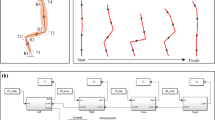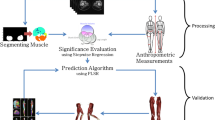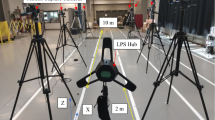Abstract
Accurate determination of body segment parameters is crucial for studying human movement and joint forces using musculoskeletal (MSK) models. However, existing methods for predicting segment mass have limited generalizability and sensitivity to body shapes. With recent advancements in machine learning, this study proposed a novel artificial neural network-based method for computing subject-specific trunk segment mass and center of mass (CoM) using only anthropometric measurements. We first developed, trained, and validated two artificial neural networks that used anthropometric measurements as input to predict body shape (ANN1) and tissue mass (ANN2). Then, we calculated trunk segmental mass for two volunteers using the predicted body shape and tissue mass. The body shape model (ANN1) was tested on 279 subjects, and maximum deviation between the predicted body shape and the original was 28 mm. The tissue mass model (ANN2) was evaluated on 223 subjects, which when compared to ground truth data, had a mean error of less than 0.51% in the head, trunk, legs, and arms. We also compared the two volunteer’s trunk segment mass with experimental data and found similar trend and magnitude. Our findings suggested that the proposed method could serve as an effective and convenient tool for predicting trunk mass.
Graphical Abstract






Similar content being viewed by others
References
Rao G, Amarantini D, Berton E, Favier D (2006) Influence of body segments’ parameters estimation models on inverse dynamics solutions during gait. J Biomech 39:1531–1536. https://doi.org/10.1016/j.jbiomech.2005.04.014
Narang YS, Murthy Arelekatti VN, Winter AG (2016) The effects of the inertial properties of above-knee prostheses on optimal stiffness, damping, and engagement parameters of passive prosthetic knees. J Biomech Eng 138. https://doi.org/10.1115/1.4034168
Pearsall DJ, Costigan PA (1999) The effect of segment parameter error on gait analysis results. Gait Posture 9:173–183. https://doi.org/10.1016/s0966-6362(99)00011-9
Silva MPT, Ambrósio JAC (2004) Sensitivity of the results produced by the inverse dynamic analysis of a human stride to perturbed input data. Gait Posture 19:35–49. https://doi.org/10.1016/S0966-6362(03)00013-4
Fritz J, Kröll J, Schwameder H (2019) Influence of body segment parameter estimation on calculated ground reaction forces in highly dynamic movements. J Biomech 84:11–17. https://doi.org/10.1016/j.jbiomech.2018.12.008
Köhler H-P, Schüler A, Quaas F et al (2024) The influence of body segment estimation methods on body segment inertia parameters and joint moments in javelin throwing. Comput Methods Biomech Biomed Engin 27:267–275. https://doi.org/10.1080/10255842.2023.2181039
Hanavan EP (1964) A Mathematical Model of the Human Body, Aerospace Medical Research Laboratory, Wright-Petterson Air Force Base, Ohio, USA
Sheets AL, Corazza S, Andriacchi TP (2010) An automated image-based method of 3D subject-specific body segment parameter estimation for kinetic analyses of rapid movements. J Biomech Eng 132:011004. https://doi.org/10.1115/1.4000155
Martin PE, Mungiole M, Marzke MW, Longhill JM (1989) The use of magnetic resonance imaging for measuring segment inertial properties. J Biomech 22:367–376. https://doi.org/10.1016/0021-9290(89)90051-1
Huang HK, Wu SC (1976) The evaluation of mass densities of human body in vivo from CT scans. Comput Biol Med 6:337–343. https://doi.org/10.1016/0010-4825(76)90070-6
Durkin JL, Dowling JJ (2006) Body segment parameter estimation of the human lower leg using an elliptical model with validation from DEXA. Ann Biomed Eng 34:1483–1493. https://doi.org/10.1007/s10439-006-9088-6
Norton J, Donaldson N, Dekker L (2002) 3D whole body scanning to determine mass properties of legs. J Biomech 35:81–86. https://doi.org/10.1016/S0021-9290(01)00161-0
Smith SHL, Bull AMJ (2018) Rapid calculation of bespoke body segment parameters using 3D infra-red scanning. Med Eng Phys 62:36–45. https://doi.org/10.1016/j.medengphy.2018.10.001
Kudzia P, Jackson E, Dumas G (2022) Estimating body segment parameters from three-dimensional human body scans. PLoS ONE 17:e0262296. https://doi.org/10.1371/journal.pone.0262296
Liu T, Khalaf K, Hebela N et al (2021) Prediction of human male trunk mass distribution using anthropometric measurements: A feasibility study. J Biomech 122:110437. https://doi.org/10.1016/j.jbiomech.2021.110437
Spitzer V, Ackerman MJ, Scherzinger AL, Whitlock D (1996) The visible human male: a technical report. J Am Med Inform Assoc 3:118–130. https://doi.org/10.1136/jamia.1996.96236280
Pearsall DJ, Reid JG, Livingston LA (1996) Segmental inertial parameters of the human trunk as determined from computed tomography. Ann Biomed Eng 24:198–210
Varol G, Ceylan D, Russell B et al (2018) BodyNet: Volumetric Inference of 3D Human Body Shapes. In: Ferrari V, Hebert M, Sminchisescu C, Weiss Y (eds) Computer Vision – ECCV 2018. Lecture Notes in Computer Science, vol 11211. Springer, Cham, pp 20–38. https://doi.org/10.1007/978-3-030-01234-2_2
Kocabas M, Athanasiou N, Black MJ (2020) VIBE: Video Inference for Human Body Pose and Shape Estimation. 2020 IEEE/CVF Conference on Computer Vision and Pattern Recognition (CVPR). IEEE, Seattle, WA, USA, pp 5252–5262
Pishchulin L, Wuhrer S, Helten T et al (2017) Building statistical shape spaces for 3D human modeling. Pattern Recogn 67:276–286. https://doi.org/10.1016/j.patcog.2017.02.018
Robinette KM, Daanen H, Paquet E (1999) The CAESAR project: a 3-D surface anthropometry survey. In: Second International Conference on 3-D Digital Imaging and Modeling (Cat. No.PR00062), pp 380–386. https://doi.org/10.1109/IM.1999.805368
Clauser CE, McConville JT, Young JW (1971) Weight, volume, and center of mass segments of the human body. J Occup Environ Med 13:270
Dempster WT (1955) Space requirements of the seated operator: geometrical, kinematic, and mechanical aspects of the body with special reference to the limbs. Wright Air Development Center, Wright-Patterson Air Force Base, Ohio
Tian IY, Ng BK, Wong MC et al (2020) Predicting 3D body shape and body composition from conventional 2D photography. Med Phys 47:6232–6245. https://doi.org/10.1002/mp.14492
Zhu H, Zuo X, Wang S et al (2019) Detailed human shape estimation from a single image by hierarchical mesh deformation. 2019 IEEE/CVF Conference on Computer Vision and Pattern Recognition (CVPR). IEEE, Long Beach, CA, USA, pp 4486–4495
Zhu S, Mok PY (2015) Predicting realistic and precise human body models under clothing based on orthogonal-view photos. Procedia Manuf 3:3812–3819. https://doi.org/10.1016/j.promfg.2015.07.884
Anguelov D, Srinivasan P, Koller D et al (2005) SCAPE: shape completion and animation of people. ACM Trans Graph 24:408–416. https://doi.org/10.1145/1073204.1073207
Alldieck T, Kassubeck M, Magnor M (2017) Optical flow-based 3d human motion estimation from monocular video. arXiv. http://arxiv.org/abs/1703.00177
Huang Y, Bogo F, Lassner C et al (2017) Towards accurate marker-less human shape and pose estimation over time. In: 2017 International Conference on 3D Vision (3DV), pp 421–430. https://arxiv.org/abs/1707.07548
Wuhrer S, Shu C (2013) Estimating 3D Human Shapes from Measurements. Mach Vis Appl 24:1133–1147. https://doi.org/10.1007/s00138-012-0472-y
Mungiole M, Martin PE (1990) Estimating segment inertial properties: comparison of magnetic resonance imaging with existing methods. J Biomech 23:1039–1046. https://doi.org/10.1016/0021-9290(90)90319-x
Cheng CK, Chen HH, Chen CS et al (2000) Segment inertial properties of Chinese adults determined from magnetic resonance imaging. Clin Biomech (Bristol, Avon) 15:559–566. https://doi.org/10.1016/s0268-0033(00)00016-4
Makovey J, Naganathan V, Sambrook P (2005) Gender differences in relationships between body composition components, their distribution and bone mineral density: a cross-sectional opposite sex twin study. Osteoporos Int 16:1495–1505. https://doi.org/10.1007/s00198-005-1841-4
Speerin R, Needs C, Chua J et al (2020) Implementing models of care for musculoskeletal conditions in health systems to support value-based care. Best Pract Res Clin Rheumatol 34:101548. https://doi.org/10.1016/j.berh.2020.101548
Shen Y-W, Yang Y, Liu H et al (2022) Biomechanical evaluation of intervertebral fusion process after anterior cervical discectomy and fusion: a finite element study. Front Bioeng Biotechnol 10. https://doi.org/10.3389/fbioe.2022.842382
Imamura Y, Tanaka T, Suzuki Y et al (2011) Motion-Based-Design of Elastic Material for Passive Assistive Device Using Musculoskeletal Model. J Robot Mechatron 23:978–990. https://doi.org/10.20965/jrm.2011.p0978
Acknowledgements
This manuscript is based upon work supported by the Khalifa University of Science Technology [Award No FSU-2018-13].
Author information
Authors and Affiliations
Corresponding author
Ethics declarations
Conflict of interest
All authors declare that there is no conflict of interest.
Additional information
Publisher's Note
Springer Nature remains neutral with regard to jurisdictional claims in published maps and institutional affiliations.
Appendix
Appendix
1.1 Evaluation of body shape neural network
The accuracy of the body shape model was evaluated by computing the error in principal component coefficient (PCC) between the ground truth and the predictions of ANN1. The results are shown in Table 3. The mean error of the 15 principal component coefficients ranged from -0.09 for PCC5 to 0.071 at PCC3, and the standard deviation varied from 0.168 at PCC1 to 1.046 at PCC3. Among the 15 coefficients, PCC1 exhibited the smallest minimum and maximum value of -0.643 and 0.525, respectively, followed by PCC4 with a minimum and maximum value of -1.007 and 0.811, respectively. The remaining PCC varied from around 2 to 4. The 25th and 75th percentiles showed similar values of approximately -0.5 and 0.5, respectively, for all PCC except for PCC1, which had values of -0.098 and 0.11.
To visually assess the deviation between the ground truth, reconstructed body shape and predicted body shape, 3D deviation contours were computed and visualized. The distances between each point of the ground truth body shape and the corresponding point on the predicted body shape were calculated and sorted in ascending order. The 3D deviation contours were then plotted at the distance threshold of 60%, 70%, 80%, 90%, and 100% using the test dataset (279 subjects) for comparison. In addition to the deviation between the ground truth and the predicted body shape (fourth column in Fig. 3), the deviation between the reconstructed body shape (represented by the first 15 principal shape variations) and the predicted body shape was also quantified (fifth column in Fig. 3).
When using the predicted body shape as a reference, both the ground truth and the compressed body shape showed a similar deviation contour, with the magnitude of the reconstructed body shape being smaller than that of the ground truth. As the threshold increased from 60% to 100%, both the reconstructed and ground truth body shapes showed an increasing maximum deviation and area with large deviation. More specifically, the ground truth showed a relatively small deviation area of around 17 mm at the 60% threshold, while the deviation increased to around 50 mm at 100% threshold. A similar trend was found for the reconstructed body shape, with a deviation area of around 7 mm at the 60% threshold and around 28 mm at the 100% threshold.
1.2 Evaluation of tissue mass neural network
The error of segment percentage (head, arms, legs, trunk bone, trunk fat and trunk lean) between the ground truth and the predicted values was quantified on the test dataset (223 individuals). The statistics of the segment percentage error showed that mean error was relatively small and less than 0.51% (Table 4). The standard deviation of the segment percentage error varied from 0.13 in the trunk bone to 2.27 in trunk fat. The peak segment error values were smallest in the trunk bone with maximum and minimum values being -0.32% and 0.44%. This is followed by arms and head with minimum and maximum values of -1.84% and 3.22%, and -2.13% and 3.14%, respectively. The remaining peak segment error ranged from 5.87% to 9.35%. However, the 25th and 75th percentiles of segment error had relatively smaller values in the trunk bone (-0.09% and 0.08%), head (-0.47% and 0.35%), arms (-0.41% and 0.68%) but slightly larger values in the legs (-1.52% and 1.03%), trunk fat (-1.61% and 0.98%) and trunk lean (-0.87% and 1.83%).
Rights and permissions
Springer Nature or its licensor (e.g. a society or other partner) holds exclusive rights to this article under a publishing agreement with the author(s) or other rightsholder(s); author self-archiving of the accepted manuscript version of this article is solely governed by the terms of such publishing agreement and applicable law.
About this article
Cite this article
Liu, T., El-Rich, M. Subject-specific trunk segmental masses prediction for musculoskeletal models using artificial neural networks. Med Biol Eng Comput (2024). https://doi.org/10.1007/s11517-024-03100-4
Received:
Accepted:
Published:
DOI: https://doi.org/10.1007/s11517-024-03100-4




